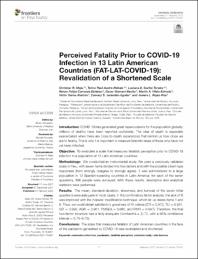Mostrar el registro sencillo del ítem
Perceived Fatality Prior to COVID-19 Infection in 13 Latin American Countries (FAT-LAT-COVID-19): Revalidation of a Shortened Scale
| dc.contributor.author | Mejia, Christian R. | es_ES |
| dc.contributor.author | Aveiro-Róbalo, Telmo Raúl | es_ES |
| dc.contributor.author | Garlisi-Torales, Luciana D. | es_ES |
| dc.contributor.author | Carranza Esteban, Renzo Felipe | es_ES |
| dc.contributor.author | Mamani-Benito, Oscar | es_ES |
| dc.contributor.author | Vilela-Estrada, Martín A. | es_ES |
| dc.contributor.author | Serna-Alarcón, Víctor | |
| dc.contributor.author | Jaramillo-Aguilar, Damary S. | |
| dc.contributor.author | Rojas-Roa, Javiera L. | |
| dc.date.accessioned | 2022-10-17T19:00:16Z | |
| dc.date.available | 2022-10-17T19:00:16Z | |
| dc.date.issued | 2022-02-12 | |
| dc.identifier.uri | https://hdl.handle.net/20.500.13053/6862 | |
| dc.description.abstract | Introduction: COVID-19 has generated great repercussions for the population globally; millions of deaths have been reported worldwide. The idea of death is especially exacerbated when there are close to death experiences that remind us how close we are to fatality. This is why it is important to measure fatalistic ideas of those who have not yet been infected. Objective: To revalidate a scale that measures fatalistic perception prior to COVID-19 infection in a population of 13 Latin American countries. Methodology: We conducted an instrumental study. We used a previously validated scale in Peru, with seven items divided into two factors and with five possible Likert-type responses (from strongly disagree to strongly agree). It was administered to a large population in 13 Spanish-speaking countries in Latin America; for each of the seven questions, 886 people were surveyed. With these results, descriptive and analytical statistics were performed. Results: The mean, standard deviation, skewness, and kurtosis of the seven initial questions were adequate in most cases. In the confirmatory factor analysis, the lack of fit was improved with the indexes' modification technique, which let us delete items 1 and 6. Thus, we could obtain satisfactory goodness-of-fit indices (CFI = 0.972, TLI = 0.931, GFI = 0.990, AGFI = 0.961, RMSEA = 0.080, and RMR = 0.047). Therefore, the final two-factor structure had a fairly adequate Cronbach's α (0.72, with a 95% confidence interval = 0.70–0.73). Conclusions: The scale that measures fatalism of Latin American countries in the face of the pandemic generated by COVID-19 was revalidated and shortened. | es_ES |
| dc.format | application/pdf | es_ES |
| dc.language.iso | Inglés | es_ES |
| dc.publisher | Frontiers in Psychiatry | es_ES |
| dc.rights | info:eu-repo/semantics/openAccess | es_ES |
| dc.rights.uri | https://creativecommons.org/licenses/by/4.0/ | es_ES |
| dc.subject | coronavirus infections, pandemics, fatalistic perception, validation study, Latin America | es_ES |
| dc.title | Perceived Fatality Prior to COVID-19 Infection in 13 Latin American Countries (FAT-LAT-COVID-19): Revalidation of a Shortened Scale | es_ES |
| dc.type | info:eu-repo/semantics/article | es_ES |
| dc.identifier.doi | https://doi.org/10.3389/fpsyt.2021.724061 | |
| dc.type.version | info:eu-repo/semantics/publishedVersion | es_ES |
| dc.publisher.country | CH | es_ES |
| dc.subject.ocde | http://purl.org/pe-repo/ocde/ford#3.03.00 | es_ES |
Ficheros en el ítem
Este ítem aparece en la(s) siguiente(s) colección(es)
-
SCOPUS [380]


